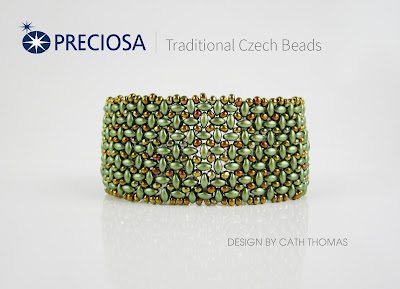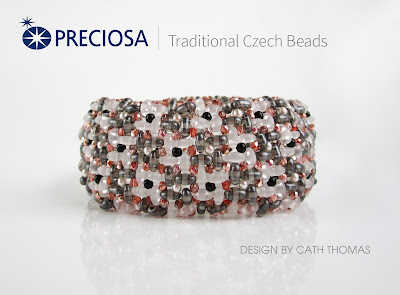 |
| Embers - curled-up all wing |
I don't think that I ever blogged about my Embers Cuff, which I made in 2015. It is a curled-up Jalisco Bangle made with twisted peyote (also called Cellini method) or, as in Contemporary Geometric Beadwork talk, an All wing. Admittedly it doesn't look like an all-wing, but that's because it is partially zipped. It could also be seen as a partially zipped 18-point (9 on each side) Yukka flower, which was actually the first 'All wing' that I made back in 2010, and where my collection of zig zag shaped creations all come from. Because they are zipped, my Yukka flowers look like puffy flowers. I like to fold and zip and curl peyote beadwork. It's so much fun.
 |
| Pepper, Fork and YukkaFlower |
To make a Rick Rack for the occasion, I looked back at Embers and thought 'why not try a Flaming Cuff on a Rick Rack start', to offer a simpler method, teachable, and maybe easier to adapt in size. It resulted in this lovely soft pink and silver "Unfinished Wave & Flames" cuff. One side is different than the other, because I made a "happy" mistake. You know, one that you decide to stick with and it results in something unexpectedly cool. I like it a lot and will take the idea further. It looks different from every angle, so I made many photos to show that.
Notice how the points and flaps twist off-center when the 'legs' of the Rick Rack are standing up, which is how it sits on the arm. These points and flaps can be twisted in various directions. It makes me think of air, of wind and of bouncing water. It is very playful.
I could take the MRAW band off, to make two separate cuffs and re-use the MRAW band. I could add pearls which would freeze the form (I love pearls). But somehow I like it as it is. Unfinished, not frozen, still modifyable.
 |
| Beading area. The birds are on the left (opposite wall). |
 |
| Postcard of a painting by Esra. |
| "Symbols" - skull painted by Esra - Acrylic on synthetic replica Photo courtesy www.esraskulls.com |
 |
| Isn't this replica amazing? Thank you, Esra! |
Esra started beading completely spontaneously many years ago. She wanted to cover bags with beads and didn't know how to bead but just went for it, without instructions or so. No internet back then. Her silk bag not only looks lovely, but is also very pleasant to touch. The way she made them is also interesting. Not RAW or DW or so. She just followed her instinct. Over the years, her love for beads only grew, and she collected many beading books including the CGB and the Diamond Weave books.
 |
| Beaded bag by Esra. |
 |
| Beaded silk bag by Esra. |
What she seemed to wonder was why an MRAW band was necessary and if hers was well done. Hers was beautiful*. To explain this subject better, I proposed to make an ordinary peyote start in the round with increases, for her to experience how fast it becomes stiff due to thread tension. My Trapezino appears to be a cool project for this, because it is not too big, and also shows the magic of folding beadwork. I also showed Esra the clever method proposed by Diane Fitzgerald to better control thread tension in long peyote starts (as explained for her Celtic Trefoil design published in a beading magazine). This way, Esra would have all the elements in hands to better understand why the MRAW band is so practical, but also why Kate is so busy developing news ideas, that is to cast beadwork off of triangles or squares (which offers starts for multiples of 3 or of 4).
 |
| One of the two trapezinos made together |
Esra left happy, and so I felt happy.
And now I am going back to my beading trays and see if I can make more flames and waves and flowers... and transform that skull!
*Esra included round beads in her MRAW band which made them softer and discreter than if they had been made with cylinder beads only. The result was very beautiful.
**the zig zag shape of a Rick Rack only appears after a certain number of peyote rows added to the MRAW base. Due to the angle of the peaks (which is approx. 62° depending on the type of beads used, generally Delica or Aiko cylinder beads), the circumference of the beadwork will be more than twice as narrow than it initially was.














